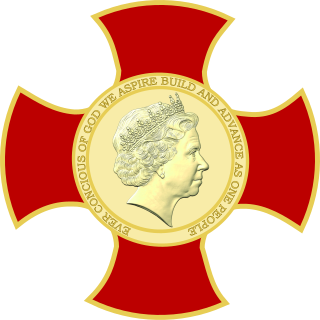
The Most Noble Order of the Garter is an order of chivalry founded by Edward III of England in 1348. The most senior order of knighthood in the British honours system, it is outranked in precedence only by the decorations of the Victoria Cross and the George Cross. The Order of the Garter is dedicated to the image and arms of Saint George, England's patron saint.

The Most Excellent Order of the British Empire is a British order of chivalry, rewarding contributions to the arts and sciences, work with charitable and welfare organizations, and public service outside the civil service. It was established on 4 June 1917 by King George V and comprises five classes across both civil and military divisions, the most senior two of which make the recipient either a knight if male or dame if female. There is also the related British Empire Medal, whose recipients are affiliated with, but not members of, the order.

The Most Distinguished Order of Saint Michael and Saint George is a British order of chivalry founded on 28 April 1818 by George, Prince of Wales, while he was acting as prince regent for his father, King George III. It is named in honour of two military saints, Michael and George.

The New Zealand Order of Merit is an order of merit in the New Zealand royal honours system. It was established by royal warrant on 30 May 1996 by Elizabeth II, Queen of New Zealand, "for those persons who in any field of endeavour, have rendered meritorious service to the Crown and nation or who have become distinguished by their eminence, talents, contributions or other merits", to recognise outstanding service to the Crown and people of New Zealand in a civil or military capacity.
The Australian honours and awards system refers to all orders, decorations, and medals, as instituted by letters patent from the Monarch of Australia and countersigned by the Australian prime minister at the time, that have been progressively introduced since 14 February 1975. The Australian honours and awards system excludes all state and local government, and private, issued awards and medals.

The Order of St John, short for Most Venerable Order of the Hospital of Saint John of Jerusalem and also known as St John International, is a British royal order of chivalry constituted in 1888 by royal charter from Queen Victoria and dedicated to St John the Baptist.

The Royal Victorian Order is a dynastic order of knighthood established in 1896 by Queen Victoria. It recognises distinguished personal service to the monarch, members of the royal family, or to any viceroy or senior representative of the monarch. The present monarch, King Charles III, is the sovereign of the order. The order's motto is Victoria. The order's official day is 20 June. The order's chapel is the Savoy Chapel in London.

Dame Calliopa Pearlette Louisy is a Saint Lucian academic, who served as governor-general of Saint Lucia from 19 September 1997, until her resignation on 31 December 2017. She is the first woman to hold the vice-regal office.

Sir Julian Robert Hunte, SLC, KCMG, OBE, was the Minister of Foreign Affairs of Saint Lucia from April 2001 to 26 October 2004, when he was succeeded by Petrus Compton. He is the Permanent Representative for Saint Lucia to the United Nations, after presenting his credentials to the Secretary-General of the United Nations on 7 December 2004.

Sir (William) George Mallet GCSL GCMG CBE was a politician who was Governor-General of Saint Lucia and held a number of high offices in the island Saint Lucia, one of the Windward Islands of the Lesser Antilles in the Eastern Caribbean. Sir George served as the Minister for Trade, Industry, Agriculture and Tourism in the first post-independence government of St Lucia beginning in 1979. In later years, Sir George served as Deputy Prime Minister and was responsible for numerous government ministries including Foreign Affairs, Home Affairs and CARICOM Affairs.
The Governor-General of Australia has, at irregular intervals, notified for general information notifies the positioning of wearing of Australian orders, decorations and medals in the Commonwealth of Australia Gazette. The Order of Wearing Australian Honours and Awards was last published in 2007.
Sir Allen Montgomery Lewis was a Saint Lucian barrister and public servant who twice served as the country's Governor-General.

The Most Distinguished Order of the Nation is an Antiguan and Barbudan order of chivalry recognising distinguished and outstanding service to Antigua and Barbuda, the CARICOM region or the international community. Originally established by the National Awards Act 1987, that act was repealed and the order was re-established and constituted by the Parliament of Antigua and Barbuda under the National Honours Act 1998 which received Royal Assent from the Governor General of Antigua and Barbuda on 31 December 1998.
The Order of Wearing of Australian honours includes Imperial honours if they were awarded prior to 6 October 1992. Imperial honours awarded after 5 October 1992 are considered foreign.
Sir Stanislaus James was a Saint Lucian educator, administrator, and former governor-general.

The Order of Grenada is an order of chivalry and a society of honour instituted by Queen Elizabeth II in right of Grenada through the Grenada National Honours Act of 1994. The Order was subsequently reconstituted and substantially reformed by the National Honours and Awards Act of 2007.
The Central Chancery of the Orders of Knighthood has, at irregular intervals, notified for general information the positioning of the wearing of Orders, decorations, and medals of the United Kingdom in the London Gazette. The Order of Wear was last published in 2019.










